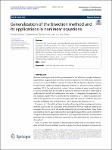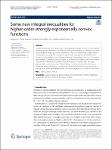Search
Author
- Carlos, Alegría (2)
- Carlos, Seara (2)
- David, Orden (2)
- Klaus, Bretterbauer (2)
- next >
Subject
Date issued
Has File(s)
- true (287)
Search Results
Understanding the impact of collective social phenomena in epidemic dynamics is a crucial task to effectively contain the disease spread. In this work, we build a mathematical description for assessing the interplay between opinion polarization and the evolution of a disease. The proposed kinetic approach describes the evolution of aggregate quantities characterizing the agents belonging to epidemiologically relevant states and will show that the spread of the disease is closely related to consensus dynamics distribution in which opinion polarization may emerge. |
The aim of the current work is to generalize the well-known bisection method using quantum calculus approach. The results for different values of quantum parameter q are analyzed, and the rate of convergence for each q∈(0,1) is also determined. Some physical problems in engineering are resolved using the QBM technique for various values of the quantum parameter q up to three iterations to examine the validity of the method. Furthermore, it is proven that QBM is always convergent and that for each interval there exists q∈(0,1)
for which the first approximation of root coincides with the precise solution of the problem. |
We propose an efficient mesh adaptive method for the numerical solution of time-dependent partial differential equations considered in the fixed space-time cylinder Ω×(0,T). We employ the space-time discontinuous Galerkin method which enables us to use different meshes at different time levels in a natural way. The mesh adaptive algorithm is based on control of the interpolation error in the L∞(0,T;Lq(Ω))-norm. |
Integral inequalities with generalized convexity play an important role in both applied and theoretical mathematics. The theory of integral inequalities is currently one of the most rapidly developing areas of mathematics due to its wide range of applications. In this paper, we study the concept of higher-order strongly exponentially convex functions and establish a new Hermite–Hadamard inequality for the class of strongly exponentially convex functions of higher order. Further, we derive some new integral inequalities for Riemann–Liouville fractional integrals via higher-order strongly exponentially convex functions. These findings include several well-known results and newly obtained results as special cases. We believe that the results presented in this paper are novel and will b... |
A fundamental invariant of an oriented 3-manifold M emerging from quantum topology is its “Kauffman bracket skein module” Sk(M) introduced by Przytycki [76] and Turaev [88]. This is the Q(A)-vector space formally spanned by all framed links in M, modulo isotopy equivalence and the linear relations, |
This article determines the fluid motion underlying coupled linear internal and surface waves in a deep-water two-fluid-layer model (with the lower layer being of infinite depth). A detailed Eulerian description of the wave-field kinematics for coupled linear travelling waves is achieved using phase-plane analysis. The qualitative motion of individual fluid particles is elucidated through analysis of the relevant nonlinear dynamical systems from the Lagrangian viewpoint. |
We study the extent to which divisors of a typical integer n are concentrated. In particular, defining Δ(n):=maxt#{d|n,logd∈[t,t+1]}, we show that Δ(n)⩾(loglogn)0.35332277… for almost all n, a bound we believe to be sharp. This disproves a conjecture of Maier and Tenenbaum. We also prove analogs for the concentration of divisors of a random permutation and of a random polynomial over a finite field. Most of the paper is devoted to a study of the following much more combinatorial problem of independent interest. |
We develop a theory of finite element systems, for the purpose of discretizing sections of vector bundles, in particular those arising in the theory of elasticity. In the presence of curvature, we prove a discrete Bianchi identity. In the flat case, we prove a de Rham theorem on cohomology groups. We check that some known mixed finite elements for the stress–displacement formulation of elasticity fit our framework. |
In this paper, we study limiting embeddings of Besov-type and Triebel-Lizorkin-type spaces, idτ:Bs1,τ1p1,q1(Ω)↪Bs2,τ2p2,q2(Ω) and idτ:Fs1,τ1p1,q1(Ω)↪Fs2,τ2p2,q2(Ω), where Ω⊂Rd
is a bounded domain, obtaining necessary and sufficient conditions for the continuity of idτ
. This can also be seen as the continuation of our previous studies of compactness of the embeddings in the non-limiting case. Moreover, we also construct Rychkov’s linear, bounded universal extension operator for these spaces. |
The research focuses on the application of AI in the field of urban morphology. The research takes urban blocks as a case study and treats urban block-related high-resolution images as data. The aim is to train an AI model to automatically detect urban block to conduct further quantitative analysis. |










